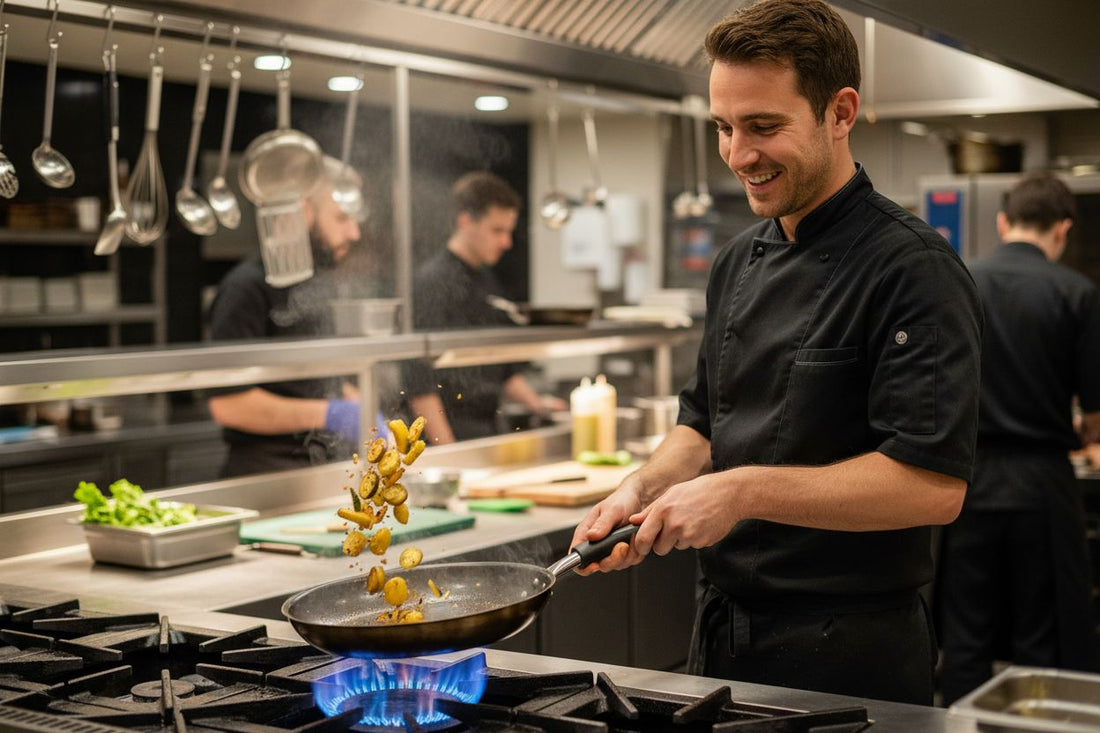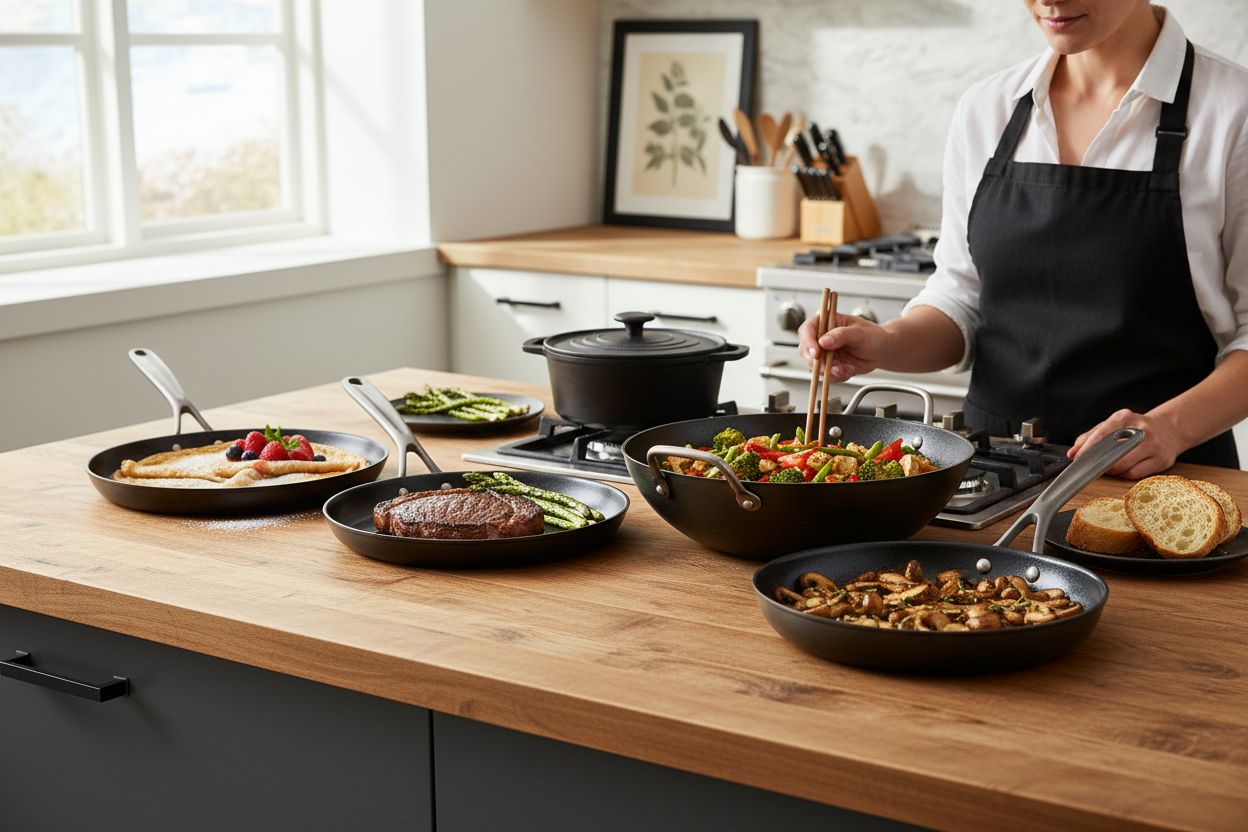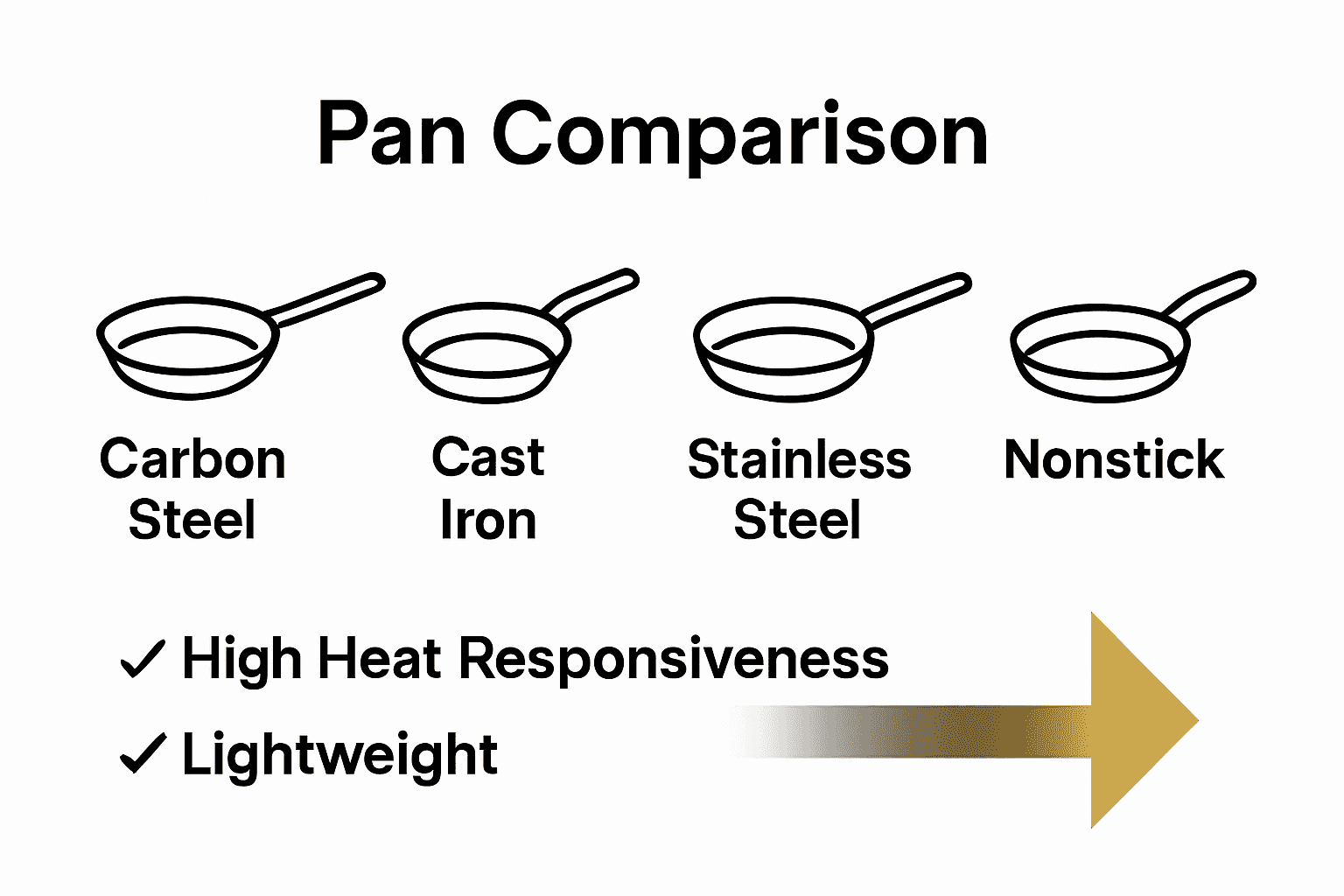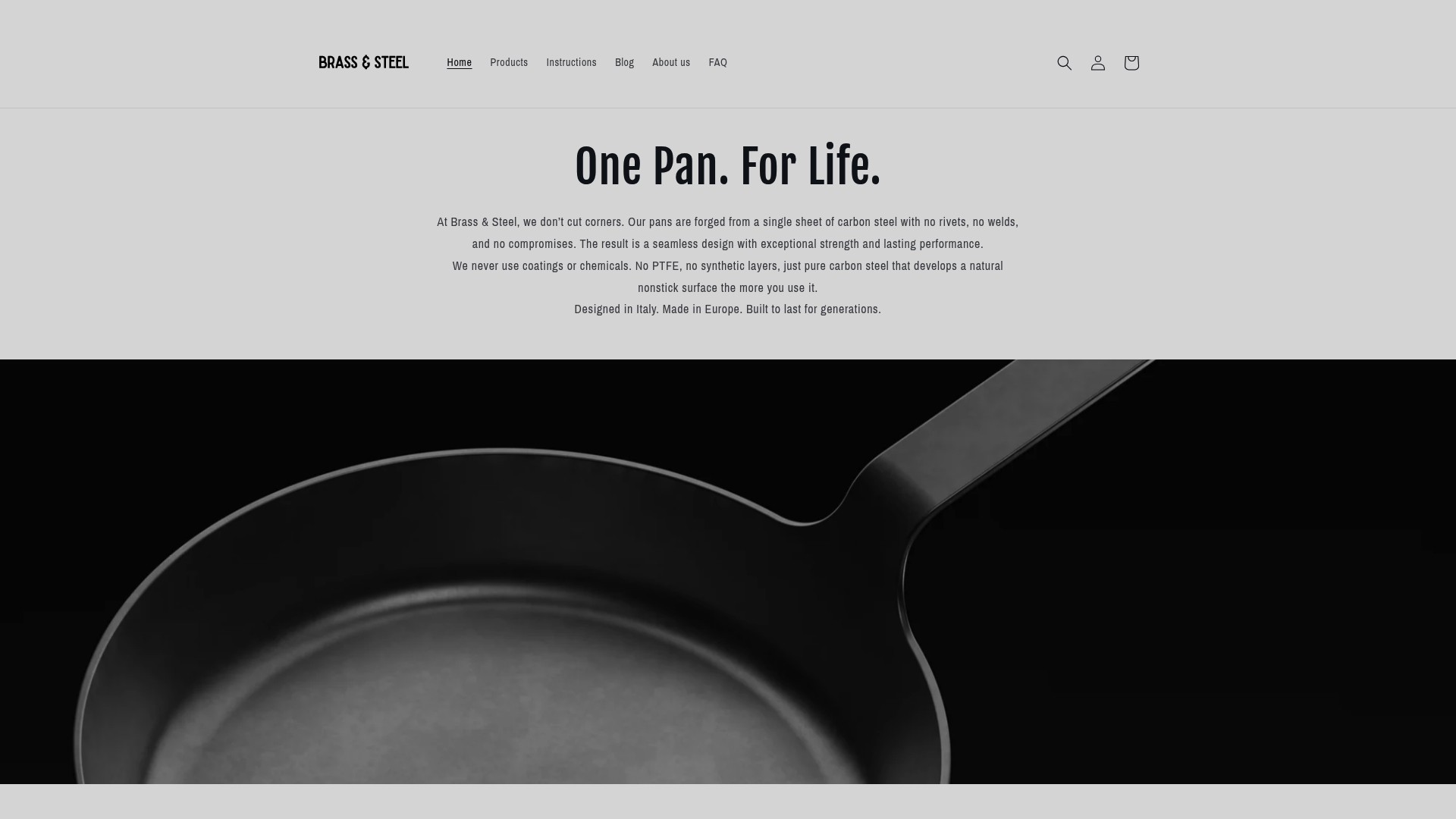
Complete Guide to Choosing Carbon Steel Cookware
Share
Did you know that professional chefs often reach for carbon steel pans because they heat up twice as fast as cast iron? Home cooks and gourmet restaurants alike are turning to this material for its superior cooking control and quick response to temperature changes. Understanding what sets carbon steel cookware apart can help you get the most out of every meal, from perfect omelettes to high-heat stir fries, with reliable results and lasting kitchen value.
Key Takeaways
| Point | Details |
|---|---|
| Versatile Performance | Carbon steel cookware excels in rapid heat distribution and temperature control, making it ideal for various cooking techniques, including stir-frying and searing. |
| Natural Nonstick Properties | Proper seasoning creates a chemical-free, nonstick surface that improves over time, enhancing cooking performance and convenience. |
| Lightweight and Durable | Compared to cast iron, carbon steel is significantly lighter, offering durability and ease of use for both professional chefs and home cooks. |
| Maintenance is Key | Regular seasoning, gentle cleaning, and immediate drying are essential practices to maintain the cookware’s integrity and performance. |
Table of Contents
- Defining Carbon Steel Cookware And Core Properties
- Types And Construction Of Carbon Steel Pans
- Performance Benefits And Cooking Applications
- Health And Safety Aspects Of Carbon Steel
- Comparing Carbon Steel To Other Cookware Materials
- Proper Care, Seasoning, And Maintenance Steps
Defining Carbon Steel Cookware and Core Properties
Carbon steel cookware represents a remarkable intersection of culinary engineering and traditional cooking techniques. At its core, carbon steel is a versatile material crafted by rolling or hammering dense metal sheets into thin, precision-engineered cooking surfaces. Learn more about carbon steel pan properties.
Unlike other cookware materials, carbon steel offers extraordinary performance characteristics. According to research, it heats up and cools down remarkably swiftly due to exceptional thermal conductivity, which provides chefs extraordinary cooking control. This rapid heat responsiveness makes carbon steel ideal for delicate cooking tasks like preparing eggs, omelettes, and fish - especially after proper seasoning.
Key properties that distinguish carbon steel cookware include:
- Rapid Heat Distribution: Quickly and evenly spreads heat across the cooking surface
- Lightweight Construction: Significantly lighter than traditional cast iron
- Natural Nonstick Surface: Develops a protective patina through seasoning
- High Heat Tolerance: Withstands extremely high cooking temperatures
- Versatile Cooking Performance: Suitable for stovetop, oven, and open flame cooking
The magic of carbon steel lies in its unique seasoning process.
By polymerizing oil onto the pan’s surface, chefs create a low-tack cooking surface that simultaneously protects against rust and enhances culinary performance. This natural nonstick layer develops over time, transforming the pan into a cherished kitchen tool that improves with each use.
Types and Construction of Carbon Steel Pans
Carbon steel cookware comes in a diverse range of designs engineered for specific culinary tasks. According to traditional manufacturing techniques, these pans are meticulously produced by rolling or hammering dense metal sheets into precise, thin constructions that deliver exceptional heat performance. Explore our comprehensive carbon steel cooking techniques.
Traditional carbon steel pans typically manifest in several primary configurations, each tailored for distinct cooking requirements:
- Crêpe Pans: Ultra-thin, wide surfaces perfect for delicate pancakes and thin French-style crepes
- Fry Pans: Versatile round pans with slightly sloped sides ideal for sautéing and general cooking
- Woks: Deep, curved designs optimized for high-heat stir-frying and quick cooking techniques
- Sauté Pans: Straight-sided pans with larger surface areas for professional kitchen environments
The construction process is a testament to precision engineering. Manufacturers transform carbon steel sheets through controlled rolling and hammering techniques that create robust yet incredibly conductive cooking surfaces. These manufacturing methods ensure the pan maintains exceptional thermal responsiveness while providing durability that can withstand intense culinary environments.
What truly distinguishes high-quality carbon steel pans is their seamless, single-piece construction. Unlike other cookware with multiple welded components, superior carbon steel pans are forged from a single metal sheet.
 This approach eliminates potential weak points, creates smoother cooking surfaces, and enhances overall structural integrity - making them a preferred choice for professional chefs and passionate home cooks seeking reliable, long-lasting cookware.
This approach eliminates potential weak points, creates smoother cooking surfaces, and enhances overall structural integrity - making them a preferred choice for professional chefs and passionate home cooks seeking reliable, long-lasting cookware.
Performance Benefits and Cooking Applications
Carbon steel cookware emerges as a culinary powerhouse, offering unparalleled performance across diverse cooking scenarios. Discover advanced cooking techniques with carbon steel, these pans represent a remarkable fusion of engineering and gastronomic precision.
According to recent product reviews, carbon steel’s most compelling attribute is its exceptional thermal responsiveness. As culinary experts highlight, these pans heat up and cool down rapidly, providing chefs extraordinary temperature control. This characteristic makes carbon steel particularly exceptional for techniques requiring split-second heat management, such as:
- Stir-Frying: Instant heat distribution for perfect wok cooking
- Searing Meats: Rapid, even heat for creating restaurant-quality caramelization
- Delicate Protein Cooking: Smooth surface ideal for eggs, fish, and fragile ingredients
- High-Temperature Techniques: Withstands intense heat without warping
When it comes to specialized cooking, carbon steel woks stand out dramatically. Research indicates they are significantly lighter than traditional cast iron while maintaining superior durability. Their ability to sear ingredients quickly and respond instantaneously to heat adjustments makes them the preferred choice for professional and home chefs alike. The pan’s smooth, adaptable surface transforms from delicate egg preparations to intense stir-frying without missing a beat, offering unprecedented versatility in a single cooking tool.
Health and Safety Aspects of Carbon Steel
Carbon steel cookware represents a remarkable intersection of culinary performance and health-conscious design. Learn more about our comprehensive health and safety approach, these pans offer a natural, chemical-free cooking experience that prioritizes both kitchen performance and user wellness.
According to recent research from The Guardian, carbon steel cookware stands out as an exceptional PFAS-free cooking alternative. Unlike synthetic non-stick surfaces that may contain potentially harmful ‘forever chemicals’, carbon steel provides a naturally occurring non-stick surface through careful seasoning. This approach eliminates exposure to potentially dangerous synthetic coatings while delivering superior cooking performance.
Key health and safety considerations for carbon steel cookware include:
- Chemical-Free Cooking Surface: No synthetic coatings or harmful chemicals
- Natural Seasoning Process: Creates protective patina through safe cooking oils
- Rust Prevention: Requires proper maintenance to ensure long-term safety
- Iron Supplementation: Potential minimal iron transfer during cooking
- High-Temperature Durability: Withstands intense cooking without chemical breakdown
The critical aspect of carbon steel safety lies in its maintenance. As Wikipedia notes, proper seasoning and drying are essential to prevent rust and maintain the cookware’s integrity. This ongoing care not only preserves the pan’s performance but also ensures a safe, hygienic cooking environment. By understanding and implementing proper seasoning techniques, home cooks can transform their carbon steel cookware into a reliable, health-conscious kitchen tool that delivers exceptional culinary results without compromising safety.
Comparing Carbon Steel to Other Cookware Materials
Cooking enthusiasts often find themselves navigating a complex landscape of cookware options. Explore the nuanced differences between cookware materials, with carbon steel emerging as a standout performer in culinary versatility.
According to recent comparative studies, carbon steel demonstrates remarkable advantages over traditional materials like cast iron. While both require seasoning and share similarities in cooking performance, carbon steel distinguishes itself through superior thermal dynamics. As culinary experts note, carbon steel heats and cools significantly faster, offering chefs unprecedented temperature control and precision.
Key comparative characteristics include:
- Cast Iron: Exceptional heat retention, heavy, slower temperature response
- Carbon Steel: Rapid heating, lightweight, precise temperature management
- Stainless Steel: Non-reactive, dishwasher safe, less natural nonstick properties
- Aluminum: Lightweight, rapid heat distribution, prone to warping
- Nonstick Surfaces: Chemical coatings, limited high-heat performance
The critical distinction lies in thermal responsiveness. Carbon steel provides a delicate balance between the robust heat retention of cast iron and the nimble temperature control demanded by sophisticated cooking techniques. Its lightweight nature combined with exceptional heat distribution makes it an ideal choice for professional kitchens and home cooks seeking a versatile, high-performance cooking surface that adapts quickly to culinary demands.

Here’s how carbon steel compares to other common cookware materials:
| Property | Carbon Steel | Cast Iron | Stainless Steel | Nonstick (PTFE) |
|---|---|---|---|---|
| Heat Responsiveness | Very fast | Slow | Moderate | Fast |
| Weight | Lightweight | Heavy | Moderate | Very light |
| Nonstick Ability | Develops naturally | Develops naturally | Low (unless coated) | Excellent (when new) |
| Heat Tolerance | Extremely high | Extremely high | High | Limited (200–260°C) |
| Chemical Additives | None | None | None | PTFE/PFAS present |
| Maintenance Required | Regular seasoning | Regular seasoning | Minimal | Avoid metal utensils |
Proper Care, Seasoning, and Maintenance Steps
Carbon steel cookware requires a specific maintenance approach that transforms it from a raw metal surface into a naturally non-stick culinary tool. Discover our comprehensive seasoning techniques, which ensure your pan develops a perfect protective coating.
According to cookware experts, the seasoning process is both an art and a science. As research from Food & Wine indicates, successful seasoning involves applying multiple thin oil coats that polymerize under heat, creating a durable protective layer. The key is patience and precision:
- Thoroughly clean the pan
- Dry completely to prevent rust
- Apply a razor-thin oil layer
- Heat until oil just begins to smoke
- Allow to cool and repeat process 2-3 times
Maintenance best practices include:
- Regular Light Oiling: After each use, apply a minimal oil coating
- Gentle Cleaning: Use warm water, avoid harsh scrubbing
- Immediate Drying: Prevent rust by thoroughly drying after washing
- Avoid Acidic Foods: Limit tomato-based or highly acidic dishes during early seasoning stages
- Re-Season Periodically: Every 10-15 uses to maintain non-stick surface
Warning: Over-seasoning can create a ridged, flaking surface, so moderation is crucial. Your carbon steel pan will develop a beautiful dark patina over time, becoming more non-stick and resilient with each carefully maintained cooking session.
Experience the Precision of True Carbon Steel Cookware with Brass & Steel
Have you spent hours researching the right cookware, only to remain undecided about which carbon steel pan will truly elevate your kitchen? Choosing between build quality, nonstick performance, and safety can feel overwhelming, especially when you want an heirloom-quality pan that actually delivers. If control, health, and lasting performance matter to you, there is a solution that answers every challenge highlighted in our guide.

Step beyond uncertainty and discover the handcrafted excellence of the Carbon Steel Collection by Brass & Steel. Every pan is forged from a single sheet, with no rivets or welded joins, giving you a seamless experience for both home cooks and professionals. Our natural nonstick pans require only seasoning to deliver restaurant-level performance and are entirely free from synthetic coatings. Feel the difference of precise heat control and enjoy cooking with confidence on all hobs, including induction.
Experience why our professional carbon steel cookware outperforms the competition. Make the switch today and give yourself the tools serious cooks deserve. Visit Brass & Steel to browse our collection and secure your heirloom pan before the next production run closes.
Frequently Asked Questions
What is carbon steel cookware?
Carbon steel cookware is made by rolling or hammering dense sheets of steel into thin cooking surfaces. It combines the properties of cast iron and stainless steel, offering excellent heat conductivity, lightweight construction, and a natural nonstick surface when seasoned properly.
How do I season a carbon steel pan?
To season a carbon steel pan, clean it thoroughly, dry it completely, apply a thin layer of oil, heat the pan until the oil starts to smoke, and let it cool. Repeat this process 2-3 times to develop a durable nonstick coating.
What are the benefits of using carbon steel cookware over other materials?
Carbon steel cookware heats up and cools down quickly, offering superior temperature control. It is lighter than cast iron, has excellent heat tolerance, and can develop a natural nonstick surface without harmful chemicals, making it a versatile choice for many cooking techniques.
Can I use acidic foods in carbon steel pans?
It’s best to avoid cooking acidic foods, such as tomato-based dishes, in a new carbon steel pan, as they can strip away the seasoning. Once the pan is well-seasoned, it becomes more resilient, but moderation is key in the initial stages of use.